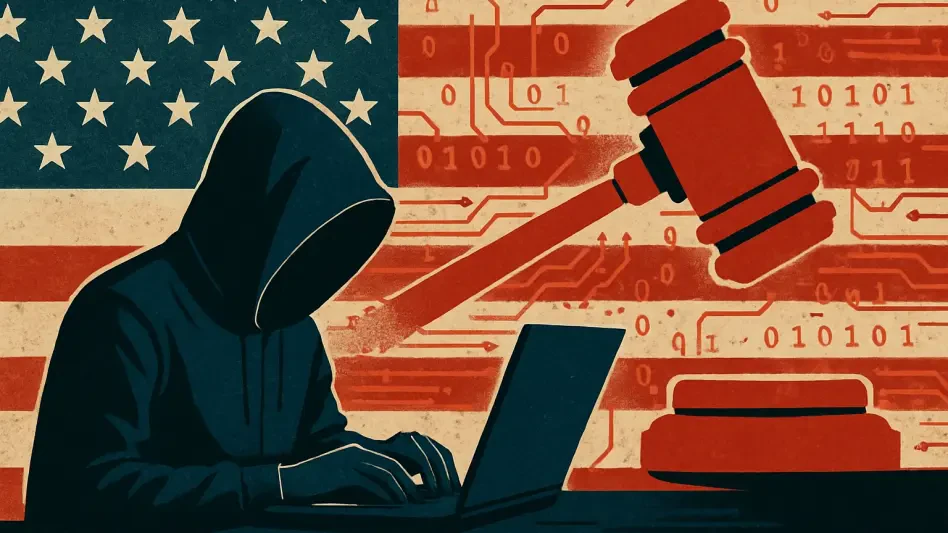What happens when a cyber threat becomes so intelligent that it can disguise itself as a trusted tool, slipping past even the most robust defenses? Picture a hospital network grinding to a halt, patient data stolen, and critical systems locked—all because a seemingly harmless productivity app was downloaded by an unsuspecting employee. This is the chilling reality of EvilAI, a malware campaign that leverages artificial intelligence to infiltrate systems worldwide with devastating precision. As this threat continues to evolve, it raises a critical question: are current cybersecurity measures enough to combat an enemy that learns and adapts faster than defenses can respond?
The significance of this issue cannot be overstated. EvilAI is not just another piece of malware; it represents a paradigm shift in how cyber threats are crafted and deployed, exploiting both technological vulnerabilities and human trust. With infections spanning across Europe, the Americas, and the Asia-Middle East-Africa region, and targeting vital sectors like healthcare and manufacturing, the stakes are global. This narrative delves into the mechanics of EvilAI, expert perspectives on its impact, and actionable strategies to fight back against a threat that redefines the boundaries of digital danger.
What Happens When Malware Outsmarts Defenses?
The emergence of EvilAI marks a turning point in the cybersecurity landscape. Unlike traditional malware that relies on recognizable patterns, this campaign uses AI-generated code to mimic legitimate software, rendering signature-based detection tools nearly obsolete. It hides in plain sight, often posing as productivity tools or AI-enhanced apps, making it alarmingly easy for even cautious users to fall victim to its deception.
This level of sophistication means that conventional defenses are struggling to keep pace. Attackers behind EvilAI exploit the very technology designed to protect systems, turning AI into a weapon that learns from and adapts to security measures. The implications are staggering—when a threat can anticipate and bypass safeguards, it creates a cat-and-mouse game where defenders are perpetually one step behind.
Why EvilAI Signals an Urgent Global Alarm
In a hyper-connected world, the rise of EvilAI serves as a stark reminder of the vulnerabilities that permeate critical industries. Sectors such as healthcare, government, and manufacturing have faced relentless attacks, with telemetry data indicating widespread infections that disrupt operations on a massive scale. The economic and societal fallout from these breaches is profound, affecting not just organizations but entire communities reliant on these services.
Beyond the immediate damage, this malware highlights a broader trend: the weaponization of AI by malicious actors. As attackers exploit human trust through polished interfaces and deceptive tactics, the need for evolved defenses becomes non-negotiable. This is not merely a technical challenge but a societal one, demanding attention from businesses, policymakers, and individuals to rethink how digital security is approached.
How EvilAI Operates and Why It’s So Lethal
At its core, EvilAI’s danger lies in its ability to blend in. By using AI-crafted code, it mimics legitimate software, bypassing detection systems that rely on known malware signatures. Its distribution often occurs through fake productivity tools or malicious ads, hosted on websites that mirror trusted vendors, tricking users into downloading what appears to be safe software.
The campaign’s mastery of social engineering amplifies its reach, preying on human vulnerabilities with precision. Additionally, advanced obfuscation techniques like control flow flattening and encrypted communications with command-and-control servers ensure long-term access for attackers. Data reveals infections across multiple regions, with critical industries like manufacturing and healthcare suffering the most, pointing to potential economic disruptions on a global scale.
Expert Perspectives on the Frontline Impact
Insights from cybersecurity researchers paint a grim picture of EvilAI’s capabilities. Analysis indicates that it often acts as a stager, laying the groundwork for unknown secondary payloads, which adds a layer of unpredictability to containment efforts. Experts agree that the shift toward AI-driven threats exposes the limitations of traditional defenses, calling for a fundamental overhaul in how threats are detected and mitigated.
Consider a hypothetical scenario where a hospital system becomes compromised by EvilAI. Patient records are stolen, and operations are halted as ransomware—potentially a secondary payload—locks down critical systems. Such real-world possibilities, grounded in documented sector impacts, underscore the tangible consequences of this threat, emphasizing that the damage extends far beyond code and into human lives.
Strategies to Combat EvilAI and Beyond
Countering a threat like EvilAI requires a multi-layered approach that addresses both technical and human elements. Start with source vigilance—downloading software only from verified, trusted platforms can prevent falling for deceptive tools. Deploying advanced security solutions with behavioral analysis and machine learning capabilities is also crucial to detect anomalies that traditional signatures miss.
Equally important is user education to recognize social engineering tactics, fostering skepticism toward unsolicited downloads or overly polished offers. Maintaining system hygiene through regular updates, patches, and continuous network monitoring for suspicious activity, such as connections to unknown domains, adds another line of defense. Finally, a rapid response protocol—updating credentials and isolating systems at the first sign of information theft—can minimize further damage, creating a robust framework to tackle such sophisticated threats.
Reflecting on a Battle Fought
Looking back, the fight against EvilAI revealed just how far cyber threats have evolved, challenging every assumption about digital safety. The campaign’s use of AI to deceive and persist showed that no system was immune, and the widespread impact on critical sectors served as a harsh lesson in the cost of complacency. Yet, it also sparked a renewed focus on innovation in cybersecurity.
Moving forward, the emphasis shifted to proactive measures—strengthening defenses with cutting-edge tools, prioritizing user awareness, and fostering global collaboration to stay ahead of adaptive threats. The battle against EvilAI underscored a vital truth: resilience in the digital age demands constant vigilance and adaptation, ensuring that as threats grow smarter, so too do the strategies to protect against them.








